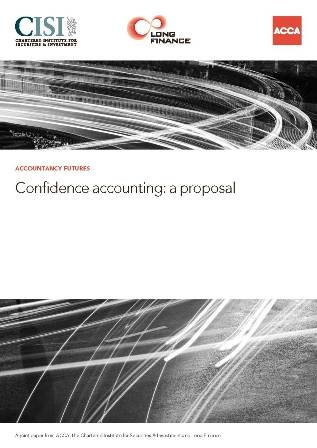Confidence Accounting
A Bold Proposal from Long Finance, ACCA and CISI
Confidence Accounting is a proposal to use distributions, rather than discrete values, where appropriate in auditing and accounting. In a world of Confidence Accounting, the end results of audits would be presentations of distributions for major entries in the profit & loss, balance sheet and cashflow statements. The proposed benefits of Confidence Accounting include a fairer representation of financial results, reduced footnotes, more measurable audit quality and a mitigation of mark-to-market perturbations. The landmark, free-to-download report was published on 5 July 2012 (press release):
Confidence Accounting: A Proposal
by Ian Harris, Michael Mainelli and Jan-Peter Onstwedder of Z/Yen Group
published by ACCA, Long Finance and CISI.
July 2012
63 pages
Andy Haldane, Executive Director for Financial Stability at the Bank of England welcomes the proposal and writes in the foreword, “My hope is that this proposal moves our thinking a step closer towards a set of accounting standards for major entities that put systemic stability centre stage. In the light of the crisis, anything less than a radical re-think would be negligent.”
Responses to the July 2012 report are available online. The publication included a invitation to readers to comment on the content of the proposal. A questionnaire was circulated during events and was also available online. Read the Confidence Accounting Consultation Responses for more information.
For a quick introduction to Confidence Accounting, particularly its application to banking, in 2011 the CISI published “Accounting for Confidence” which provides a short overview. Confidence Accounting was introduced for the non-professional in “The Price of Fish: A New Approach to Wicked Economics and Better Decisions”, winner of the 2012 Independent Publisher Book Awards Finance, Investment & Economics Gold Prize.
Read More
- Edward D. Weinberger (2015): Financial Statement Items as Interlinked Stochastic Processes. IMA Research Incubator, Grant Final Report.
- John Davies (2014): Courting Confidence. Accountancy Futures, ACCA: page 40.
- Michael Mainelli (2014): What Has Accounting Got To Do With The Price Of Fish? Economia, Institute of Chartered Accountants of England and Wales.
- Michael Mainelli (2014): Comment: Accountants Could Benefit From Thinking Like Engineers. Engineering & Technology Magazine.
- Michael Mainelli (2014): Why Spurious Financial Precision May Be Killing Our Markets – And Our Fish. City AM.
- David Rowe (2014): Prudent Valuation Versus Confidence Accounting. Risk Magazine.
- ACCA & Long Finance (2013): Confidence Accounting Consultation Responses.
- Investment Management Review (2013): Revolutionary Accounting Method Proposed.
- Michael Mainelli & Jan-Peter Onstwedder (2012): Buried Treasure Naturally Confident – Accounting For Resources. The CA, Institute of Chartered Accountants of Scotland.
- Michael Mainelli (29 July 2012): The Battle For Accountancy Has Begun. Financial Times, FTfm, Pearson PLC: page 6.
- Eric Tracey (2012): Confident Accounting. Financial Director.
- Michael Mainelli (2011): Accounting For Confidence. Securities & Investment Review: pages 22-23.
- Michael Mainelli (October 2011): Banking On Confidence: Rethinking Audits Of Financial Institutions. Corporate Governance and Sustainability Challenges.
- Michael Mainelli (2009): Confidence Accounting: Putting Essential Uncertainty Back Into Auditing And Accounting. EURO CFO Ltd, Aerial.
- Michael Mainelli (June 2009). Confidence Accounting: Putting Essential Uncertainty Back Into Accountancy. Journal of Risk Finance, Vol.10 (No.3). Emerald Group Publishing Limited.
- 2006 Symposium: Reforming Auditing - Incremental Change Or Radical Action?
Citations
- David M. Bholat. (July 2013): "The Future of Central Bank Data". Journal of Banking Regulation.
